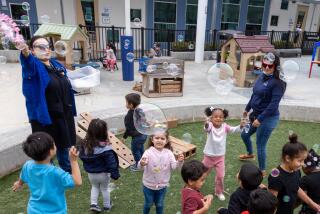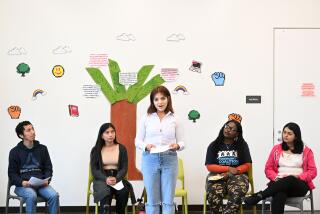Op-Ed: How to improve distance learning for our youngest students
- Share via
Many teachers, students and their families can agree on one thing after experiencing the unexpected hurricane that was distance learning this spring: It must improve — especially in the earliest grades, transitional kindergarten through second grade.
Our youngest students, from ages 4 to 9, need more supervision throughout the day and help with the technology that enables learning. They are developmentally different from their older peers in ways that significantly impact how they best learn. Distance-learning practices must reflect that reality.
As educational researchers, we learned from conversations with teachers, school leaders, parents and early-education experts what strategies were effective for initiating and sustaining student engagement in the spring. Anyone responsible for supporting young students in distance learning could benefit from employing these approaches.
Obviously, distance instruction is not the same as in-person instruction and should not look the same. Sure, some strategies can transfer to a distance classroom, but forcing distance learning to look like “normal” school is trying to put a square peg in a round hole and will only hurt our youngest students.
California requires at least 180 minutes of instructional time a day for kindergarten students and 230 minutes for Grades 1 through 3. Setting this expectation is critical for ensuring students receive daily interaction with teachers and their peers. However, many districts, including Los Angeles Unified, have struggled with determining how much instruction should be given through live, uninterrupted video streams. LAUSD is giving teachers broad leeway on that front.
Even adults have trouble videoconferencing for long stretches. For the youngest students, it is nearly impossible.
It’s an ineffective strategy for younger students for an obvious reason — they have shorter attention spans. But the livestream approach also emphasizes the quantity of instruction without giving enough attention to quality.
In a traditional classroom, young students spend significant amounts of time learning in small groups with peers rather than with the whole class, so that teachers can provide individualized feedback, more easily conduct lessons, and intentionally facilitate social interactions between students. Distance classrooms should mirror this approach.
Live instruction in distance classrooms should be structured around short interactive lessons, with synchronous learning opportunities — where students learn together at the same time — broken into smaller chunks throughout the day. Teachers should have multiple opportunities to interact with students one-on-one and in smaller groups, and they should make it a priority to use learning activities that allow students to work together.
Play is essential for learning and key to young students’ development of interpersonal skills, as well as their social emotional well-being. There are many creative ways teachers can reach beyond the computer screen to facilitate play.
Games such as “Simon Says” help build executive-functioning skills and provide an opportunity for energetic young students to move. Technology can be used to facilitate play and engagement between students through various education applications and games. Teachers can also use interactions similar to “carpet time” to foster engagement where students interact with materials or items individually and share their creations with their teacher and classmates.
And as families know all too well, young students need ongoing adult engagement to guide their distance learning. To support parents, schools and districts such as San Francisco Unified are partnering with community organizations that traditionally support students to provide learning spaces and trained staff to help students to safely complete distance learning lessons. And teachers only have so much time, so maintaining regular contact with student families should not just fall to them — counselors and non-instructional staff should help out.
In the spring, some teachers created flexible lessons that families could adapt to the time and resources available to them. Providing students and parents with options for different activities drives engagement while being responsive to family needs. Regular check-ins with a student’s family should serve as a troubleshooting opportunity, whether it’s about the academics or the family’s well-being.
In addition, lessons focused on topics important to students’ families can also help bring culturally relevant instruction to the fore.
Teachers should provide alternatives to student learning as a group by offering at-home work that can be completed on their own or away from the computer. These might include online literacy, numeracy and math, and science lessons as well as such activities as guided reading in any language or building math skills through daily activities such as cooking or telling time.
Just as in a brick-and-mortar classroom, young students should be encouraged to display their mastery of new concepts, which could be accomplished through apps, verbal sharing and small-group conversations.
In the spring, many schools and districts did not do a good enough job communicating expectations to parents. Teachers and schools need to make sure families and students understand their roles in making distance learning work. A clear schedule should be provided that establishes the time, for example, for whole-class morning meetings, guided readings, the teacher’s office hours, and the blocks of time for instruction.
Improving distance education in ways that support student learning this fall will require meaningful changes in practice and tighter collaboration between schools and families. Distance education is here for the foreseeable future. We need to get better at it.
Benjamin Cottingham and Alix Gallagher are educational researchers at Policy Analysis for California Education.
More to Read
A cure for the common opinion
Get thought-provoking perspectives with our weekly newsletter.
You may occasionally receive promotional content from the Los Angeles Times.










